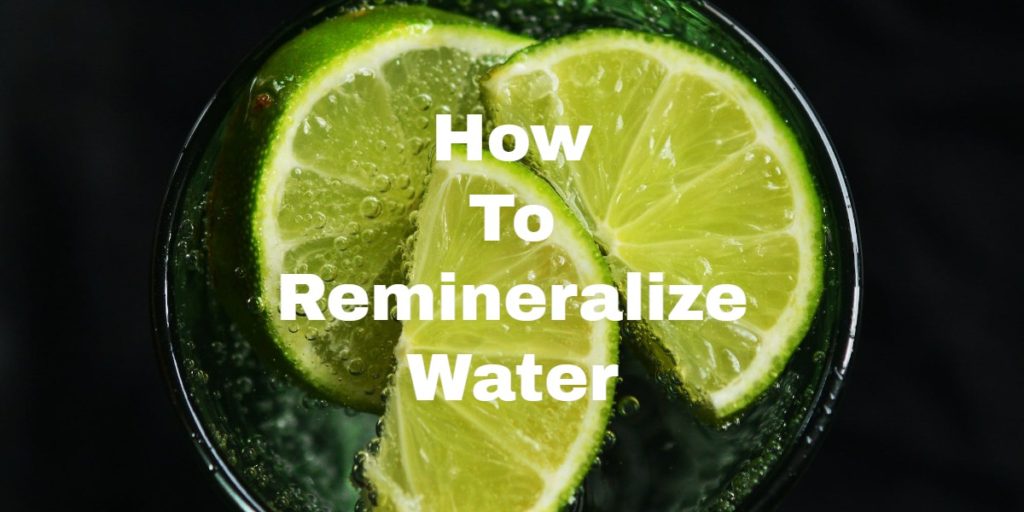How To Remineralize Water: DIY, Filters, Drops and Stones
Drinking water isn’t just about hydration; it’s also a vital source of minerals that our bodies need. However, not all water is equal when it comes to mineral content. This brings us to the concept of remineralizing water, or more specifically, how to remineralize water. I have vowed to increase the quality of the water I drink this year. I think most people have a good handle on filtering, but my research, based on articles and interviews with Robert Slovak, Dr. Gerald H. Pollack, and other water experts, shows that, even though it is cleaner, many of the minerals that you actually want in the water are not as rich as you would want.
I currently take Quinton Isotonic Water and have experimented with hydrogen water tablets. Since water is such an essential nutrient I wanted to dig even deeper into the subject and see if I could come up with a do-it-yourself way to mineralize water rather than paying for Topo Chico, San Pellegrino, or Fiji (I enjoy them all).
Why Remineralize Water?
Health Benefits of Minerals in Drinking Water
Water naturally contains minerals such as calcium, magnesium, and potassium, which play crucial roles in our health. For instance, calcium aids in bone health, magnesium supports nerve and muscle function, and potassium helps maintain fluid balance in the body.
Improving the Taste of Water with Minerals
Apart from health benefits, minerals also improve the taste of water. I have always claimed there was something special to Fiji water and this must be why. This is why tap water and bottled spring water taste different from distilled or reverse osmosis water.
How to Remineralize Water Using 4 Different Methods
There are several ways to add minerals back to your water.
Remineralizing with Mineral Drops
Mineral drops are a simple and effective way to increase the mineral content of your water. Just add a few drops to your water and you’re good to go. These are typically available online or at health food stores. Some popular brands include Trace Minerals Research, Concentrace, and EMDROPS, but it’s always good to do your own research to find the product that best suits your needs.
Using Remineralizing Filter Systems
Certain water filtration systems come with a remineralization feature. They work by adding minerals to the water after it has been purified.
Remineralizing Naturally with Mineral Stones
Mineral stones, like Maifan stones, release mineral elements into the water, effectively increasing their mineral content. Mineral stones are easy to use for water remineralization. Here’s a simple step-by-step guide:
- Purchase Mineral Stones: These can usually be found online or at health food stores. Maifan stones are a popular choice.
- Clean the Stones: Before use, it’s important to clean the mineral stones. Rinse them under running water to remove any dust or loose particles. Some people also choose to boil the stones for about 10-15 minutes for a thorough cleaning, but it’s important to refer to the instructions that come with the stones as some types may not be suitable for boiling.
- Place the Stones in Water: Add the mineral stones to your water container. It could be a water filter pitcher, a jug, or any other container that you use for drinking water.
- Wait: Allow the water to sit with the stones for a few hours. During this time, the stones slowly release minerals into the water.
- Enjoy: After a few hours, the water is remineralized and ready to drink.
- Maintenance: Remember to clean the stones periodically to maintain their effectiveness. This usually involves taking them out of the water and scrubbing lightly to remove any potential algae or bacterial buildup. Some stones may also need to be replaced after a certain period of time, so be sure to check the product’s lifespan when you buy it.
DIY Methods for Remineralizing Water at Home
Remineralizing water at home can be as easy as adding a pinch of Himalayan pink salt or infusing water with trace mineral tablets. I try and do this for my first glass of water in the morning but forget quite a bit of the time.
After watching the video below, I realized I may need to increase the amount of salt I am putting in my water. I had just been doing a pinch. Dr. Alan Mandell, A south Florida, based Chiropractor, recommends in this video adding 1/2 – 1 teaspoon (5ml) of Himalayan salt to 1 cup of water (8 ounces) first thing in the morning. That is definitely a little more than a pinch.
Choosing the Right Remineralization Method for You
Factors to Consider When Choosing a Remineralization Method
Your choice of remineralization method would depend on various factors, including your budget, taste preference, and health requirements.
Pros and Cons of Different Remineralization Methods
| Method | Pros | Cons |
|---|---|---|
| Mineral Drops | Easy to use, affordable | May alter taste of water |
| Remineralizing Filters | Convenient, maintains water taste | May alter the taste of water |
| Mineral Stones | Natural, improves water taste | Takes time |
| DIY (Salt/Tablets) | Economical, simple | Not as effective |
Understanding Demineralization
What is Demineralized Water?
Demineralized water is essentially water that has been stripped of its natural mineral content. This is usually a result of processes such as reverse osmosis or distillation.
How is Water Demineralized?
Reverse osmosis is a process that pushes water through a semi-permeable membrane to remove impurities, including minerals. Similarly, distillation involves boiling water and collecting the steam, which leaves the minerals behind.
The Impact of Demineralized Water on Health
While demineralized water is free of contaminants, it lacks essential minerals that your body needs. If you drink this type of water over an extended period could potentially lead to a mineral deficiency.
Final Word on How To Remineralize Water
Remineralizing water is a significant step towards better health. It not only replenishes the vital minerals our bodies need but also improves the taste of our water. Remember, if you have any health conditions or are unsure about the process, it’s best to consult with a health professional or a water quality expert. As you can see there is more than one answer to how to remineralize water.
Frequently Asked Questions
Is Remineralized Water Safe?
Yes, remineralized water is safe for consumption. However, it’s important to ensure you’re not overdoing it as excessive mineral intake can also have negative health effects.
How Often Should You Remineralize Water?
The frequency depends on the quality of your source water and the method of remineralization you’re using. Follow the guidelines provided with specific remineralization products.
Can You Over Remineralize Water?
Yes, over-remineralization can lead to mineral overload, which may have negative health effects. It’s essential to maintain balance.
Can I remineralize water using fruits and vegetables?
Yes, adding fruits and vegetables can introduce some minerals back into the water. For example, adding a slice of cucumber or lemon to your water can provide a small amount of minerals.
Is there any risk associated with consuming demineralized water?
Long-term consumption of demineralized water may potentially lead to mineral deficiencies as your body needs certain minerals to function properly. It’s generally recommended to consume remineralized water or mineral-rich beverages.

Troy Wallace
Troy Wallace is Certified Basketball Speed Specialist and shares his experiences in trying to stay as healthy as possible to stay on the court. He is active in coaching youth basketball in YMCA, Team Work Sports Nebraska, and, currently, in the Jr. Warriors program in Omaha, NE. Visit Troy's Full Author Bio Page or email him directly.
Meaningful conversations happening daily about training, recovery, and injury-specific rehabilitation as well as sport-specific discussions on playing, coaching and refereeing your favorite sport. We welcome experts and those with curious minds seeking answers.
Join The Stay On The Court Community!



